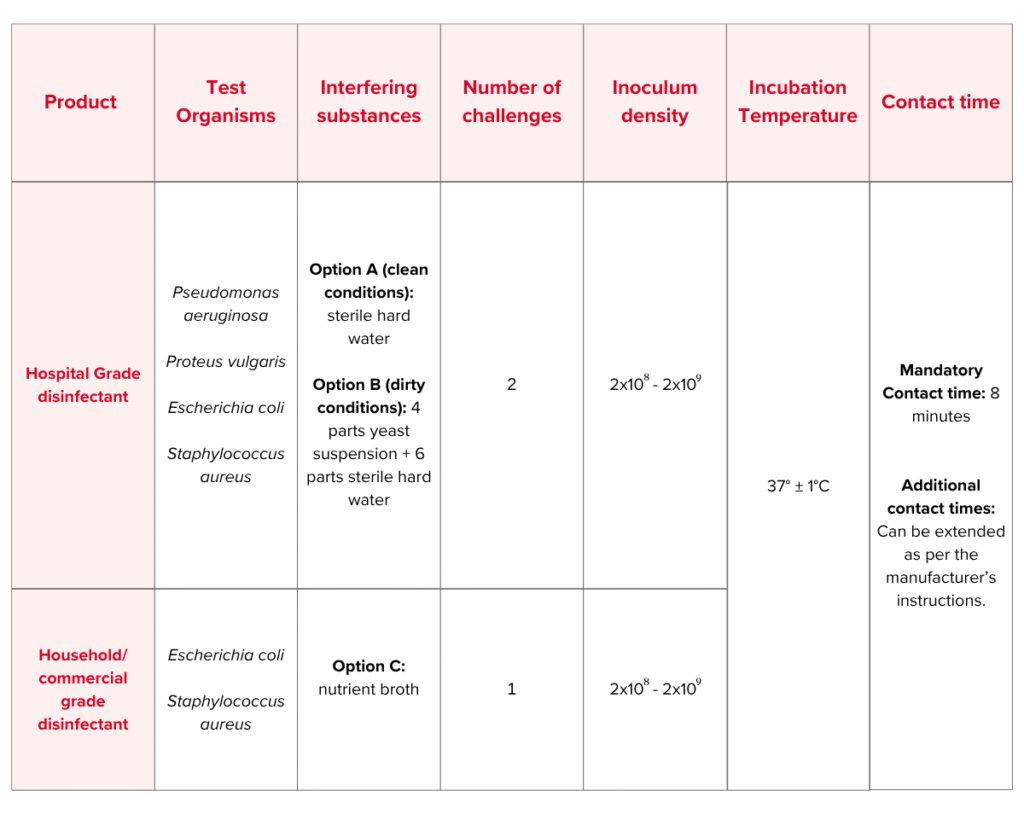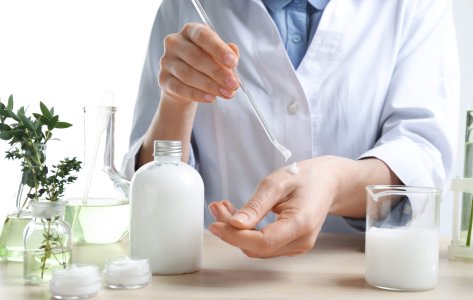- Swiss testing laboratory
TGA Disinfectant Testing

Hassle-free testing experience
Need to get a product tested? No worries! To and fro logistics are on us; we collect your products, test them and, deliver them back to you.
Related tests for you
Evaluation of bactericidal activity of disinfectants used in medical areas
Evaluating the bactericidal activity of disinfectants used in veterinary area
Evaluation of Bactericidal Activity of Chemical Disinfectant
Efficacy evalution of Surgical hand disinfectants
Efficacy evalution of Hygienic hand rubs
Evaluates efficacy of hygienic handwash products in reducing microorganisms
Quick understanding of the test
TGA Disinfectant Testing
TGA disinfectant testing is a suspension-based method used to evaluate the bactericidal efficacy of disinfectants (required test for the Australian market).
Applicable to disinfectant products claiming bactericidal efficacy, including hospital-grade disinfectants and household/commercial disinfectants.
- Pseudomonas aeruginosa (ATCC 15442)
- Proteus vulgaris (ATCC 13315)
- Escherichia coli (ATCC 8739)
- Staphylococcus aureus (ATCC 6538)
- Disinfectant is mixed with the appropriate interfering substance.
- The mixture is challenged with a known quantity of test organisms and allowed to interact for the specified contact time.
- After contact time, an aliquot of the mixture is neutralized using a neutralizer.
- After the first sampling, a second aliquot of the test organism is added to the same mixture and again exposed for specified contact period.
- At the end of the second contact time, an aliquot of the mixture is transferred into test tubes containing neutralizer.
- All tubes are incubated at 37±1 °C for 48±2 hours.
- After incubation, the tubes are examined for microbial growth.
Benefits
- Supports regulatory approval for disinfectant products marketed in Australia
- Aligns with international standards like EN 13727
Turnaround Time
The test takes approximately 3-4 weeks to complete.
Results
The disinfectant’s bactericidal efficacy is determined by assessing the test tubes for bacterial growth. The results are reported as pass or fail.
Passing criteria
To pass the test, at least 2 out of the 5 replicate tubes must show no growth.
Do you have a product that needs testing?
Abstract
The Therapeutic Goods Administration (TGA) Disinfectant Test is a suspension-based efficacy test required under Australia’s Therapeutic Goods Order 104 (TGO 104) for disinfectants. This test determines whether a disinfectant product can kill bacteria under defined conditions, which is essential for regulatory approval and label claims.
Under TGO 104, all hospital-grade and commercial-grade disinfectants must pass the TGA Disinfectant Testing to support any bactericidal claim, and other claims, such as sporicidal, fungicidal, tuberculocidal, or virucidal, must be validated using additional specific tests.
Products that can be tested
The test is applicable to a wide range of disinfectant products, including:
- Hospital-grade disinfectants: Disinfectants for medical and healthcare settings (including instrument disinfectants for medical devices) (concentrates or ready-to-use).
- Household and commercial disinfectants: Products for domestic, institutional, or industrial use (surface cleaners, general disinfectants).
- Surface disinfectant sprays and aerosols: Sprayable disinfectants for hard surfaces, tested similarly to other liquids at their use-dilution and conditions.
- Disinfectant wipes and towelettes: Pre-saturated wipes for surface disinfection (must be tested using suspension tests and carrier test)
Test Conditions and Requirements

TGA Disinfectant Test Method
1. Preparation: The disinfectant is diluted to its working concentration as per label claims (for concentrates) or used directly (for ready-to-use products). Additionally, as per the test requirements, the product shall be mixed with the appropriate interfering substance.
2. First microbial challenge: The disinfectant is challenged with a known quantity of test organisms (2×108 – 2×109).
3. Exposure: The disinfectant and test organism are allowed to interact for the specified contact time.
4. First sampling: Post-exposure period, an aliquot of (0.02ml) mixture is transferred into five test tubes containing recovery broth containing neutralizer.
5. Second microbial challenge (for hospital-grade products): After the first sampling, a second aliquot of the test organism is added to the same disinfectant mixture. This mixture is again allowed to be exposed for a specified contact period.
6. Second sampling: At the end of the second contact time, an aliquot of (0.02ml) mixture is transferred into another five test tubes containing recovery broth containing neutralizer. (Note: Household-grade disinfectants skip steps 5 & 6, since they require only a single challenge under Option C.)
7. Incubation: All recovery broth tubes are incubated at 37±1 °C for 48±2 hours.
8. Examination of results: After incubation, the broth tubes are examined for microbial growth (turbidity or colonies if plated).
Control Tests
Along with the efficacy test, multiple control tests are performed to ensure valid results: These include:
(a) a sterility control of the recovery broth (no inoculum, to confirm the broth is sterile)
(b) a disinfectant control (broth + diluted disinfectant with no bacteria, to ensure the product solution itself is not contaminated)
(c) a viability control (aka fertility test – broth + a very small inoculum of the test organism, to verify the bacteria are capable of growth and were not inadvertently killed by handling)
(d) a neutralizer efficacy control (broth + disinfectant + a small inoculum, to confirm the neutralizing solution can effectively quench the disinfectant’s activity)
Passing Criteria
The outcome is reported as pass or fail for each organism (and each test condition). According to the TGA pass criteria, each challenge is considered passed if at least 2 out of the 5 replicate tubes show no growth. In case of hospital-grade disinfectants, the criterion for both the first and second challenge must be met.
Importance of TGA Disinfectant Testing
In Australia, disinfectants are regulated as therapeutic goods, and TGO 104 establishes performance requirements to safeguard public health. Passing the TGA Disinfectant Testing is mandatory for any hospital-grade or commercial-grade disinfectant aimed to be marketed in Australia.
This test not only fulfills Australian regulatory requirements but also aligns with international standards for disinfectant efficacy. The TGA’s suspension test is analogous to other global standards (for example, the European EN 13727 quantitative suspension test for bactericidal activity). Ultimately, successful completion of TGA disinfectant testing is a key step in product registration, labeling approval, and market access in Australia.
Looking to validate your disinfectant’s efficacy for the Australian market?
Contact Microbe Investigations Switzerland to discuss TGA disinfectant testing for your product. Our experts will guide you through the process, from test design and organism selection to interpreting results, ensuring that all TGA (TGO 104) requirements are met.
Additionally, we also provide a wide range of EN test methods (including carrier tests) to ensure overall compliance of your product. Reach out to us today to ensure your disinfectant achieves the required regulatory approvals.
Frequently Asked Questions

DR. Martinoz Scholtz
The TGA disinfectant test is a suspension-based method used to evaluate the bactericidal efficacy of disinfectants (required test for the Australian market).
The TGA disinfectant test is applicable to disinfectant products claiming bactericidal efficacy, including hospital-grade disinfectants and household/commercial disinfectants.
The test takes approximately 3- 4 weeks to complete.
As per the TGA guidelines, disinfectants are tested using Pseudomonas aeruginosa, Proteus vulgaris, Escherichia coli and Staphylococcus aureus.
Meet the best of the blend of
R&D, Efficacy Testing,
Innovation and Passionate
Experts at MIS.





Explore More
In the cosmetics industry, safety
Evidently, with the expanding cosmetics
In the competitive world of





